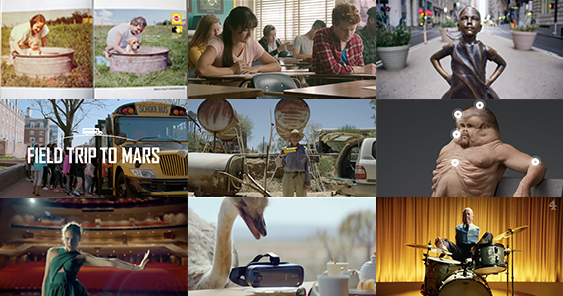Words by Leo Balante and Harriet Icay
The Gunn Report has revealed its annual rankings of the world’s most creative advertising campaigns and the companies that created them. Dubbed as the global index of creative excellence in advertising, the rankings comprise of the 100 best creative ideas, along with the best-performing agencies, networks, holding companies, brands, advertisers, and countries.
This year, the methodology used by the report has essentially changed, while continuing to be grounded by the very fundamental principles that have made it a revered list through the years. This year’s rankings saw the introduction of Gunn 100, which is the fruition of the integration of Gunn Report into the ownership of global marketing intelligence firm WARC and its annual rankings of campaigns and companies based on effectiveness and strategy.
With Gunn 100, this year’s rankings give recognition to 100 of the best creative ideas in the world, regardless of its communication discipline. In a WARC statement, “This replaces the previous channel-specific rankings of film, print, OOH, digital, and ‘all guns blazing’, to reflect the rise of cross-channel campaign ideas and their success in awards shows.
Gunn 100 combines the winner lists from over 40 of the best global, regional, and national awards shows to establish the annual worldwide league tables for creativity in advertising.This year, among 68 countries which registered their points, only 25 countries were represented in the Top 100.
For two consecutive years, the US, UK, and Australia top the rankings holding the first, second, and third places, respectively. The US placed number one with the biggest margin ever, 8669.62, and has 24 of the top 100 campaigns, while the UK got 9 of the 100 campaigns and 12 out of 100 campaigns for Australia.
Europe tops the regions for creativity with 33 campaigns, followed by ASPAC with 32, North America with 27, Latin America with six, and the Middle East and North Africa with two campaigns.
Among the top brands for creativity saw Nike on top of the rankings. After an unusually low 12th place last year, Nike bounced back to take first place in the brands’ table for the fifth time. It had two campaigns in the top 100, with a further 19 from across all the regions contributing to their total. Volkswagen and Ikea follow.
The Volkswagen group claims top rank in the top advertisers for creativity, with both Volkswagen and Audi ranking in the top 10 brands. It also had two campaigns in the top 100 and a further 30 across all regions that contributed to its tally.
AlmapBBDO is the top-ranked agency for the fourth time in the 19 years of Gunn Report. BBDO placed second and two other BBDO agencies also made the top 10, contributing to their ranking as the top agency network. Third place was claimed by Dentsu Tokyo. The top three agencies each created more than 15 different award-winning campaigns for a wide range of clients.
BBDO worldwide tops the ranking for agency networks for creativity 12 years in a row, followed by McCann Worldgroup and Ogilvy & Mather.
Omnicom leads the way as the world’s most creative agency holding company. Three of the top six networks—BBDO Worldwide, DDB Worldwide and TBWA Worldwide—are owned by Omnicom. It is followed by WPP and Interpublic.
The Gunn Report also presents three recurring themes that emerged from the world’s most creative campaigns: A year of ‘purpose’, creativity meets tech, and emotion drives film-led work.
Making an impact and driving action is the soul of purpose-driven marketing campaigns. The theme continues to dominate the creative awards—as seen in the 2018 results—with a notable number of brands (as opposed to charities or not-for-profit organizations) using social or environmental causes in their advertising. Examples from the top 10 include “Fearless girl” for State Street Global Advisors, and
“Child Replacement Program” for Pedigree.
In the age of big data and technology and automation, it is no wonder that another strong theme that surfaced is the melding of creativity and tech. High-ranking campaigns that found innovative ways to use emerging tech on behalf of brands include “Field Trip to Mars” for Lockheed Martin, and “Land cruiser Emergency Network” for Toyota.
Lastly, the mix of emotional engagement and high production values was a recurring theme in film-led campaigns. The three minutes of “We’re the Superhumans” to promote Channel 4’s coverage of the Paralympics never fails to invoke a heart-warming and inspirational response. Another superb example of great stunning direction was Kenzo’s “My Mutant Brain” and “Evan” for Sandy Hook Promise. Samsung’s “Ostrich” is a great example of both an emotionally engaging piece of film and creativity meeting tech as we get to see an ostrich fly.
Clemenger BBDO’s “Meet Graham” for Transport Accident Commission claimed the top spot in this year’s top creative ad campaigns. The campaign showed just how ill-equipped our bodies are to endure traffic accidents through depicting what a human would have to look like to withstand a low-speed crash. Graham is a life-size interactive sculpture with a bigger and stronger skull than a normal human, and knees that can move in all directions. It is created with trauma surgeon, crash expert, and artist Patricia Piccinini. Graham received 1.2 billion media impressions in the first week of the campaign, generating $29 million in earned media. In five days, the “Meet Graham” website has been visited 10 million times.

A screenshot of the website of Meet Graham
Claiming the second place is McCann New York and State Street Global Advisors’ “Fearless Girl”. The bronze statue of a defiant, young girl staring down the iconic “Charging Bull” sculpture on New York City’s Wall Street, installed in honour of International Women’s Day.
The campaign aimed to pressure companies to add more women to their boards. The firm followed up the installation with the creation of a fund supporting female-led companies, writing an open letter to thousands of companies, asking them to act to increase gender diversity. In just 12 weeks, the campaign generated 4.6 billion Twitter impressions and 745 million Instagram impressions.
Colenso BBDO and Pedigree’s “Child Replacement Program”, which targets parents suffering from empty nest syndrome, ranked third. The campaign connects potential pets with parents who find themselves alone after their kids move out. Parents will be lead to a campaign site, where they could search for the perfect four-legged substitute for their grown-up child. Parents who adopted could even send in their child’s old possessions, exchanging them for new toys for their pooch. The campaign was Pedigree New Zealand’s most successful adoption drive since 2010, with an 824% increase in adoption inquiries and a 16% sales increase for the brand.
Special thanks to Emma Wilkie for her insights on the Gunn 100 Report.
This article was published in the adobo magazine Gender 2018 issue.







